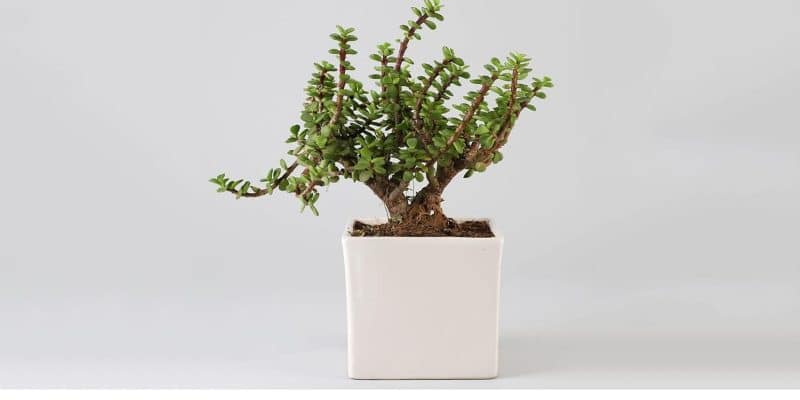The jade plant is a popular houseplant favorite — and for good reason. This hardy, succulent plant is not only easy on the eyes, but it’s also a breeze to care for.
In this article, we’ll guide you through the ins and outs of jade plant care, including its preferred lighting and watering needs and some handy propagation steps.
whether you’re planning to spruce up your space with a cheery jade plant or simply looking to become a more knowledgeable plant parent, we’ll fill you in on everything you need to know to keep your jade plant happy, healthy, and thriving. Let’s dive in!
Table of Contents
Jade Plant Care Guide
History, Habitat, and Characteristics
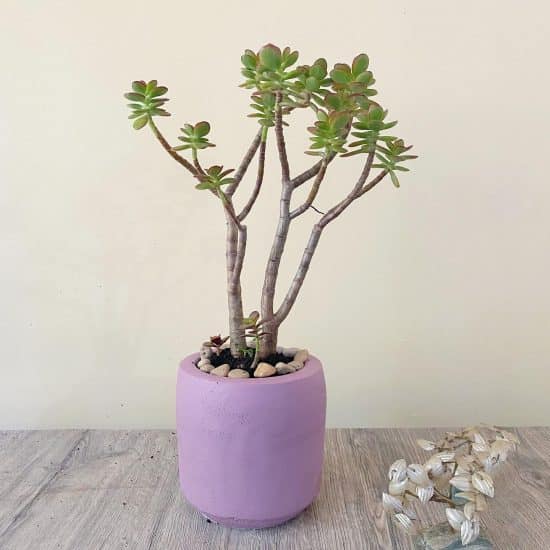
The jade plant (Crassula ovata) comes from the landscapes of South Africa, particularly the Eastern Cape region. It has thick, woody stems and round, or sometimes ovular or heart-shaped, green leaves.
Jade plant also displays delicate, star-shaped flowers arranged in tufts at the end of stems. Unfortunately, jade plants are unlikely to flower when grown indoors, but we’ll cover what you can do to help a bloom later.
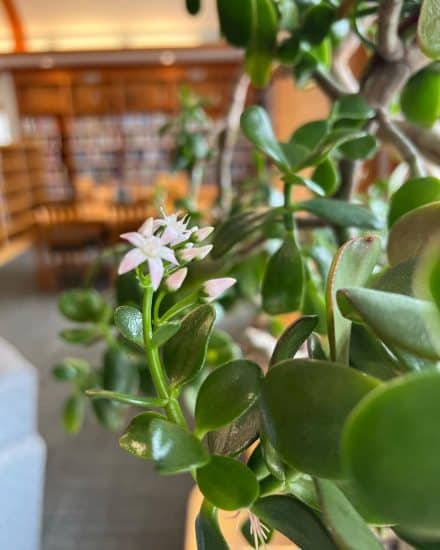
In the wild, it can grow up to 6 feet tall, shrouded from the sun beneath taller plants. They don’t get quite this tall indoors, but can still reach 3 feet tall. This gives them a charming, compact appearance, perfect for a bookshelf.
Crassula ovata flaunts a natural bonsai vibe without the need for any complicated trimming techniques. Its botanical name is a clue to its delightful characteristics: Crassula refers to the plant’s thick and swollen trunks, while ovata highlights its egg-shaped succulent foliage.
In addition to its official botanical name, the jade plant goes by the nickname “friendship plant” or “money plant.” These names showcase its symbolic associations with good luck, prosperity, and strong relationships. So the next time you want to wish someone well, a jade plant might just be the perfect gift to give!
Jade Plant Varieties
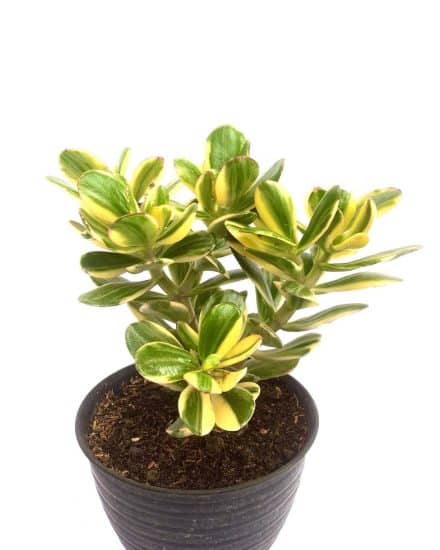
There are more than 200 different jade plant species. Since we’re not sadists, we won’t detail each one, but we will cover some of the most popular and interesting.
- Variegated Jade (Crassula ovata ‘Variegata’) – One of the most popular varieties, this one looks like the traditional jade plant except for its yellow, white, green, and potentially pink coloring. Needs bright indirect light to maintain its multicolored foliage.
- Silver Dollar Jade (Crassula arborescens) – Resembles the regular jade plant (Crassula ovata), but has blue-silver leaves with red-bordered margins.
- Tiger Jade (Crassula exilis ssp. picturata) – A dwarf jade that has narrow green leaves with red spots that grow in spiraled rosettes and a hairy stem. Produces small white to pink flowers. (Not to be confused with Jade Tower, which climbs upwards in columns).
- Jade Necklace (Crassula marnieriana) – Thick green leaves with red edges resembling discs that look like beads on . . . you guessed it, a necklace. Great for hanging baskets.
- Dwarf Jade (Crassula ovata ‘Crosby’s Compact’) – A slow-grower with many branches sporting green leaves with red borders, although new leaves can be fully red. Grows white star-shaped flowers.
- Gollum Jade (Crassula ovata ‘Gollum’) – Not to be confused with the hobbit jade (Crassula ovata ‘Hobbit’), Gollum Jade is a sport discovered in the 1970s. It’s got long green tube-like leaves that pucker up at the end and have red-tinged tips. Produces pink or white star-shaped flowers. Also sometimes called ET’s Fingers.
- Miniature Jade (Crassula ovata ‘Minima’) – A dwarf succulent growing up to 2.5 feet tall and 20 inches wide with fleshy round leaves and reddish edges. This one produces coral star-shaped flowers.
- Wave Jade (Crassula ovata ‘Undulata’) – Slow-grower with bright green, wavy leaves that have thin red borders. Can produce whitish-pink star-like clustered flowers.
There are dozens more, but you get the picture! And hopefully also some of these charming plants. On into the light!
Light
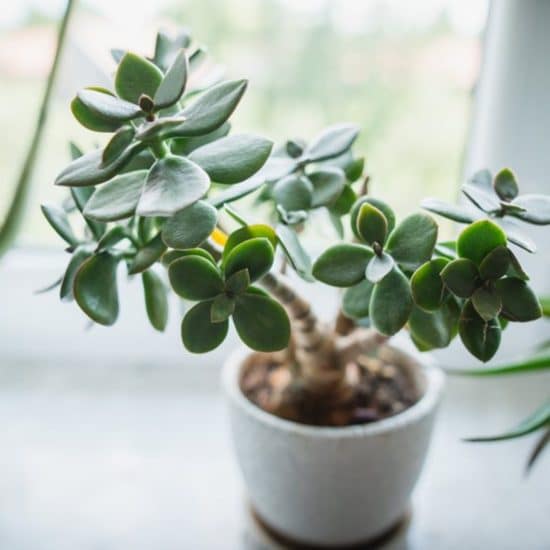
Jade plants naturally thrive in bright, sunny conditions, so providing sufficient light will encourage growth and help them flourish.
These succulent houseplants absolutely love full sun — the more, the better — and their ideal placement is in a west or south-facing window. For best results, make sure your jade plant receives at least 3-4 hours of direct light. If a bright spot isn’t available, don’t worry — jade plants can also do well under grow lights.
Now, let’s discuss recognizing the signs of insufficient light in jade plants. If your jade plant isn’t getting enough bright sunlight, it may start to exhibit slow, leggy growth, with leaves reaching toward the brightest light source they can find. The fix? Simply move your plant to a location with more light or consider using a grow light.
On the flip side, too much direct sun can also be a problem. If you notice that your jade plant’s leaves are becoming scorched, faded, or brown, it could be receiving too much direct sunlight. In this case, try adding a sheer curtain to filter the light or move the plant to a slightly less sunny spot.
Water
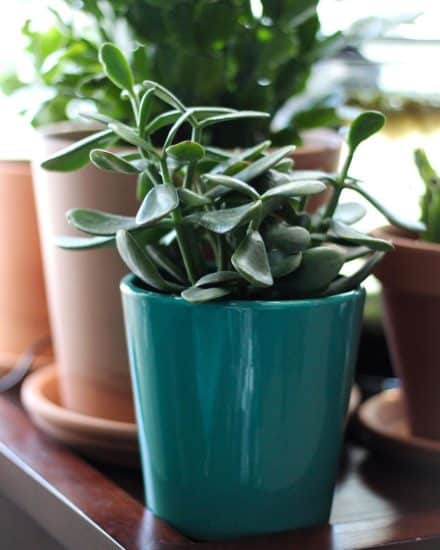
During the growing season of spring and summer, water your jade plants when the top half of the soil is dry. As winter rolls around, let them dry out a bit more. You’ll find you need to water a jade plant a bit less often as it gets colder.
Always wait until the soil is completely dry before watering them. Jade plants store water in their thick, fleshy leaves, and excess moisture can lead to leaf drop. When you do water, give these plants a thorough soak, allowing water to flow out through the drainage hole.
If your jade plant isn’t receiving enough water, you’ll notice wrinkled, dehydrated leaves. If you see the fleshy, oval-shaped leaves losing their plumpness and becoming thin and shriveled, it’s time to increase the watering frequency.
Jade plants are highly susceptible to overwatering. Too much water may result in mushy, discolored leaves, and even damage to the roots. Make sure the soil isn’t consistently damp, and if you notice yellow leaves decrease the amount of water to prevent potential damage.
Temperature and Humidity
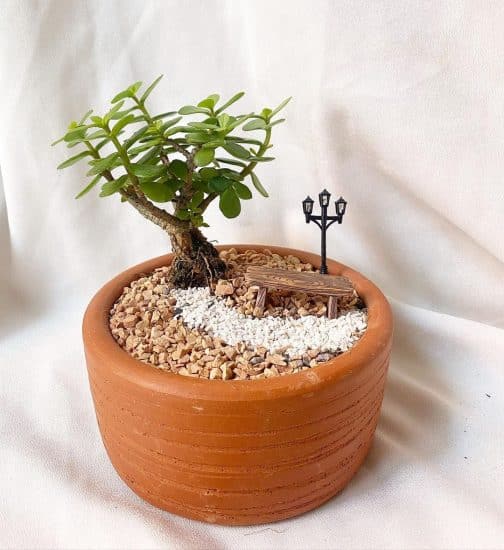
Jade plants prefer a desert-like environment with relatively high heat. The temperature should be kept within a range of 65-75°F (18-24°C) during the day, with slightly cooler temperatures at night. Keep an eye on those green leaves — if they start to shrivel, it might be a sign of excessive heat.
Jade plants thrive in low levels of humidity, so stick to normal household humidity. There’s no need to increase the relative humidity around these plants, and humidity that gets too high can encourage rot.
Soil and Planting
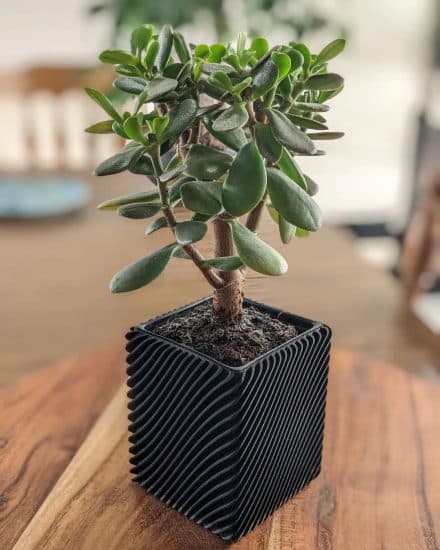
A well-drained soil is crucial for keeping your jade plant healthy. To achieve this, we recommend using a mixture of 50% all-purpose potting mix and 50% perlite.
- All-purpose potting mix: Providing jade plants with a mix that is half soil gives them essential nutrients and helps retain some moisture, but not too much.
- Perlite: This is a lightweight volcanic rock that enhances aeration and drainage within the soil, ensuring the roots have plenty of oxygen and preventing waterlogged conditions.
Jade plants actually do well when they’re a bit root-bound, which contributes to good drainage. But if you begin to notice the roots growing near the pot’s top, or out the bottom drainage holes, it’s an indication that it’s time to consider repotting your jade plant.
Root-bound jade plants also tend to grow a bit slower, so if you’re looking to embrace a more compact look, really take your time in repotting these plants.
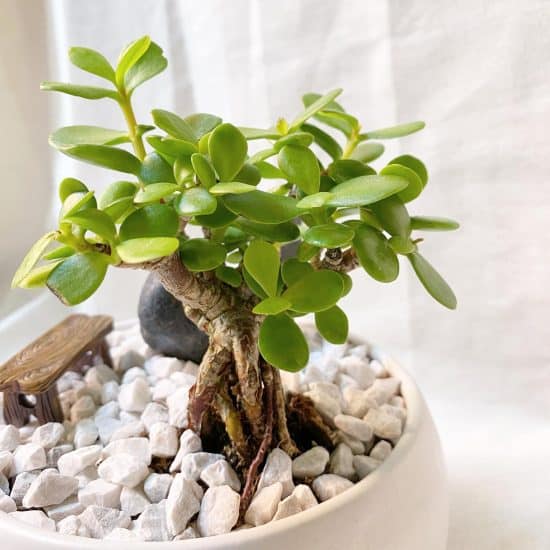
When selecting a container for your jade plant, opt for a terracotta pot instead of plastic or pots without drainage holes. Terracotta containers are breathable and dry out quicker than plastic or ceramic.
Choose a container for your jade plant that’s only slightly larger than the previous one, and — we can’t stress this enough — make sure it has drainage holes.
Propagation
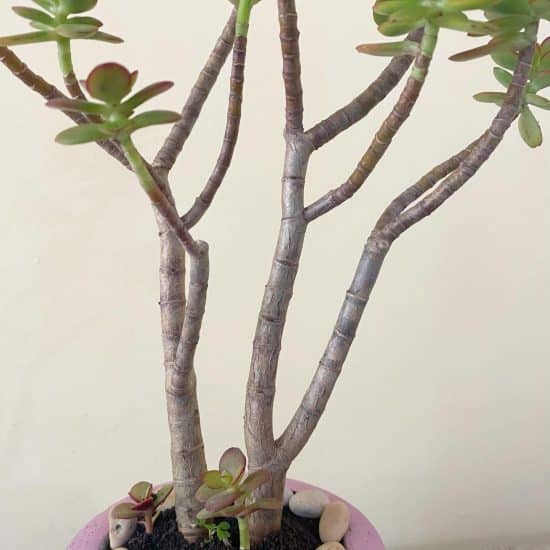
It’s easy to propagate jade plants through either stem or leaf cuttings. Just follow the steps below to ensure successful propagation and grow new jade plants.
Propagating jade plant via cutting:
- Snip your cutting: Find a healthy stem or leaf on your jade plant. Using clean, sharp pruning shears or a knife, carefully cut it away from the mother plant. If you’re taking a stem cutting, make sure it has at least two or three leaves and remove any leaves near the bottom to expose the nodes.
- Let it dry: Give your cutting some time to dry and heal. Place it in a cool, dry spot for a couple of days to let it form a callus on the cut end. This step is important to prevent rot when you’re ready to plant the cutting in soil.
- Mix up your soil: To ensure proper drainage, combine equal parts of all-purpose potting mix and perlite. Moisten the mix and fill a small pot or container with drainage holes.
- Root your cutting: Gently push the calloused end of your cutting into the soil mix, making sure the bottom nodes are covered. Press the soil around the cutting to keep it stable.
- Give it some love: Put your newly potted baby plants in a bright spot with indirect sunlight. Keep the soil slightly moist, but be careful not to overwater to avoid rot. In about six to eight weeks, you should see new growth — a sign that your propagation is a success!
Propagating via leaf cutting from mature plants is similar, only you don’t want to bury the leaf in the soil. Just gently lay it on its side and it should create babies and roots eventually. When roots appear, plant it like you would a stem cutting.
Our propagation tips:
- Choose a healthy, disease-free cutting from the mother plant in order to increase your chances of successful propagation.
- Protect your cutting from direct sunlight during the propagation process, as this can cause stress and slow rooting.
- Be patient and don’t worry if you don’t see growth straightaway; rooting and new growth can take a few weeks to appear.
- Repot young jade plants in early spring as they mature and outgrow their current pots.
Common Issues
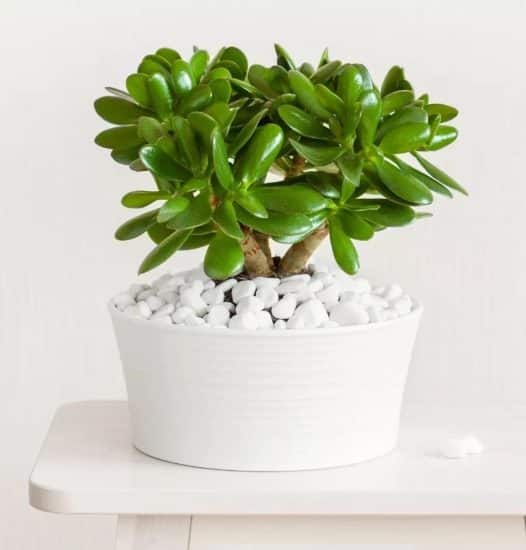
Jade plants are generally low-maintenance and easy to grow, but they can still encounter a few common problems.
Droopy Growth
It can be disheartening to see your jade plant experiencing weak, droopy growth. This issue is often caused by insufficient light exposure or excessive moisture. Fortunately, with a few adjustments, you can help your plant regain its strength and vitality.
To combat droopy growth, start by ensuring your jade plant gets at least 3-4 hours of full sun each day. When it comes to watering, don’t overdo it. Allow the soil to dry out before giving your jade plant a thorough watering, and water sparingly to prevent common pests like spider mites.
Leaf Loss
If your jade plant starts losing its leaves, you’ll first want to check that it has a light, well-draining potting mix. Heavy soil leads to too much retained water, inhibited growth, and an unhealthy root system.
Next, ensure the plant gets at least 3-4 hours of direct sunlight and bright, indirect light the rest of the day.
In terms of watering, always wait until the soil feels dry to the touch before giving your jade plant a thorough soaking.
Pests and Diseases
Root Rot
Overwatering is a common reason behind a struggling jade plant. Combine that with insufficient light, and you’ve got a recipe for root problems, leaf decay, and a sad-looking plant. The result is usually root rot, which causes weak slimy stems and wilting leaves. If you notice a rotten smell coming from your plant, it may be root rot.
If you spot signs of root trouble, remove your jade plant from its pot and trim away any affected roots. Let it dry out for a day or two, then repot it in fresh, well-draining soil. In the future, let the soil dry out before you water again. The less-is-more approach works wonders for jade plants.
Preventing these issues is actually pretty simple. Just make sure your jade plant is potted in well-draining soil, use a pot with proper drainage holes, and ensure it’s the right size for the plant.
Pests
Sometimes jade plants can cross paths with uninvited guests, like mealybugs. You’ll recognize these little troublemakers as small, white, cottony masses on the leaves and stems. These pests can weaken your plant and cause the leaves to fall off.
Isolate your affected jade plant from any other plants you have. Gently remove the mealybugs using a soft brush or cloth, paying extra attention to leaf undersides. After the initial cleanup, apply insecticidal soap, neem oil, or rubbing alcohol as a treatment. Keep your plant out of direct sunlight while you are treating it with any insecticide or other application.
Repeat the process every week or two until you’re sure the mealybugs are history.
Conclusion
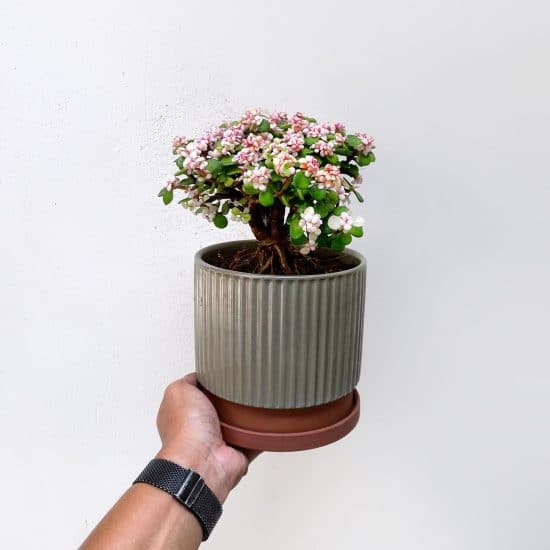
That’s a wrap for our guide on how to grow jade plants! These succulents are super easy to care for and make a perfect plant for beginners.
Jade plant care summary:
- Jade plants require bright light, with at least 3-4 hours of direct sunlight each day. Keep them in south- or west-facing windows.
- Wait until the soil is completely dry before watering, and water less in winter.
- Use a well-draining soil mix, ideally a 50/50 blend of potting soil and perlite.
- Ensure warm temperatures of 65-75°F (18-24°C) and maintain low humidity levels.
By following this guide and providing your jade plant with consistent care and attention, you’ll be rewarded with a lush, healthy addition to your indoor garden. As always, if you have any questions or require further assistance, don’t hesitate to reach out — we’re here to help!
Take care and happy growing!
FAQ
How do you get a jade plant to bloom?
Getting your jade plant to bloom can be a delightful surprise, as these plants are not well-known for their pink flowers.
To encourage blooming, let’s explore four aspects of care:
- Light: Ensure that your jade plant is exposed to plenty of sunlight. These plants need at least four hours of direct sunlight daily to encourage blooming, so place your jade near a bright window or outside during the warmer months.
- Temperature: Jade plants prefer cooler temperatures during their dormant period (winter months), which can encourage blooming. Aim for a temperature range of 50-55°F (10-13°C) during this time, and avoid exposing the plant to drastic temperature fluctuations.
- Watering: Reduce watering during the dormant period. Always wait for the soil to dry out between waterings, and avoid over-watering, as this can prevent blooms from forming.
- Fertilizer: Apply a low-nitrogen, high-phosphorus fertilizer every few months to provide the necessary nutrients for blooming. Make sure not to overdo the fertilizing, as this can harm the plant.
Remember that patience is key, as jade plants often take several years to mature and produce blooms. Keep giving your jade plant the proper care and attention, and you may be rewarded with beautiful, star-shaped flowers!
Can you grow jade plants outdoors?
Yes, you can grow a jade plant outdoors – but with a few caveats. Jade plants are native to desert-like environments, so they can handle high heat and relatively low humidity. However, they are not frost-tolerant and can suffer in extreme cold temperatures.
If you live in a region with mild winters and temperatures that rarely dip below 40°F (4°C), you can grow jade plants outdoors year-round. Ideally, aim for a temperature range of 65-75°F (18-24°C) during the day, with slightly cooler temperatures at night.
Choose a location with well-draining soil and full sun exposure to help your outdoor jade plants thrive. Protect the plants from excessive rain by providing shelter or moving them to a covered area during wet periods. Keep in mind that extreme heat may cause leaf shriveling, so monitor your plant closely and adjust its location accordingly.
In colder climates, grow jade plants in containers and bring them indoors during the winter months to protect them from frost and freezing temperatures.
Are jade plants toxic?
Yes, jade plants (Crassula ovata) are considered toxic to both pets and humans, according to the ASPCA. While contact with their oval leaves is generally not harmful, ingestion of the plant can be dangerous.
Is the jade plant considered to be the money plant?
The jade plant is sometimes referred to as a money plant (or lucky plant) as their leaves are believed to symbolize wealth, prosperity, and some amount of good luck as a gift. It makes sense that they’re commonly used in feng shui to attract good fortune and positive energy.
However, more commonly, we refer to Pachira aquatica as the money plant.

